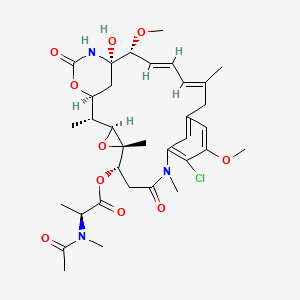| MeSH term | MeSH ID | Detail |
|---|---|---|
| Asthenia | D001247 | 5 associated lipids |
| Body Weight | D001835 | 333 associated lipids |
| Brain Diseases | D001927 | 27 associated lipids |
| Breast Neoplasms | D001943 | 24 associated lipids |
| Bronchial Spasm | D001986 | 18 associated lipids |
| Colonic Neoplasms | D003110 | 161 associated lipids |
| Hyperplasia | D006965 | 34 associated lipids |
| Hypopharyngeal Neoplasms | D007012 | 1 associated lipids |
| Leukemia | D007938 | 74 associated lipids |
| Leukemia P388 | D007941 | 43 associated lipids |
MAYTANSINE
MAYTANSINE is a lipid of Polyketides (PK) class. Maytansine is associated with abnormalities such as Myelosuppression and BOSLEY-SALIH-ALORAINY SYNDROME. The involved functions are known as Mutation, Agent, Polymerization, Cell Cycle Arrest and Drug Kinetics. Maytansine often locates in Cytoplasm, Hepatic, Lysosomes, Cell surface and Microtubules. The associated genes with MAYTANSINE are ABCB1 gene, HM13 gene, CNN1 gene, CYP2C8 gene and CYP2D6 gene. The related lipids are Valerates. The related experimental models are Xenograft Model.
Cross Reference
Introduction
To understand associated biological information of MAYTANSINE, we collected biological information of abnormalities, associated pathways, cellular/molecular locations, biological functions, related genes/proteins, lipids and common seen animal/experimental models with organized paragraphs from literatures.
What diseases are associated with MAYTANSINE?
MAYTANSINE is suspected in Myelosuppression, BOSLEY-SALIH-ALORAINY SYNDROME and other diseases in descending order of the highest number of associated sentences.
Related references are mostly published in these journals:
| Disease | Cross reference | Weighted score | Related literature |
|---|
Possible diseases from mapped MeSH terms on references
We collected disease MeSH terms mapped to the references associated with MAYTANSINE
PubChem Associated disorders and diseases
What pathways are associated with MAYTANSINE
There are no associated biomedical information in the current reference collection.
PubChem Biomolecular Interactions and Pathways
Link to PubChem Biomolecular Interactions and PathwaysWhat cellular locations are associated with MAYTANSINE?
Visualization in cellular structure
Associated locations are in red color. Not associated locations are in black.
Related references are published most in these journals:
| Location | Cross reference | Weighted score | Related literatures |
|---|
What functions are associated with MAYTANSINE?
Related references are published most in these journals:
| Function | Cross reference | Weighted score | Related literatures |
|---|
What lipids are associated with MAYTANSINE?
Related references are published most in these journals:
| Lipid concept | Cross reference | Weighted score | Related literatures |
|---|
What genes are associated with MAYTANSINE?
Related references are published most in these journals:
| Gene | Cross reference | Weighted score | Related literatures |
|---|
What common seen animal models are associated with MAYTANSINE?
Xenograft Model
Xenograft Model are used in the study 'IMGN853, a Folate Receptor-α (FRα)-Targeting Antibody-Drug Conjugate, Exhibits Potent Targeted Antitumor Activity against FRα-Expressing Tumors.' (Ab O et al., 2015).
Related references are published most in these journals:
| Model | Cross reference | Weighted score | Related literatures |
|---|
NCBI Entrez Crosslinks
All references with MAYTANSINE
Download all related citations| Authors | Title | Published | Journal | PubMed Link |
|---|---|---|---|---|
| Ponte JF et al. | Understanding How the Stability of the Thiol-Maleimide Linkage Impacts the Pharmacokinetics of Lysine-Linked Antibody-Maytansinoid Conjugates. | 2016 | Bioconjug. Chem. | pmid:27174129 |
| Fan Y et al. | Effects of modulation of pentose-phosphate pathway on biosynthesis of ansamitocins in Actinosynnema pretiosum. | 2016 | J. Biotechnol. | pmid:27173582 |
| Jacot W et al. | Efficacy and safety of trastuzumab emtansine (T-DM1) in patients with HER2-positive breast cancer with brain metastases. | 2016 | Breast Cancer Res. Treat. | pmid:27167986 |
| Sandra K et al. | Multiple heart-cutting and comprehensive two-dimensional liquid chromatography hyphenated to mass spectrometry for the characterization of the antibody-drug conjugate ado-trastuzumab emtansine. | 2016 | J. Chromatogr. B Analyt. Technol. Biomed. Life Sci. | pmid:27160547 |
| Tsuda M et al. | Abnormal Corneal Lesions Induced by Trastuzumab Emtansine: An Antibody-Drug Conjugate for Breast Cancer. | 2016 | Cornea | pmid:27149538 |
| de Goeij BE and Lambert JM | New developments for antibody-drug conjugate-based therapeutic approaches. | 2016 | Curr. Opin. Immunol. | pmid:26963132 |
| Maass KF et al. | Determination of Cellular Processing Rates for a Trastuzumab-Maytansinoid Antibody-Drug Conjugate (ADC) Highlights Key Parameters for ADC Design. | 2016 | AAPS J | pmid:26912181 |
| Vankemmelbeke M and Durrant L | Third-generation antibody drug conjugates for cancer therapy--a balancing act. | 2016 | Ther Deliv | pmid:26893243 |
| Raja SM et al. | Marked enhancement of lysosomal targeting and efficacy of ErbB2-targeted drug delivery by HSP90 inhibition. | 2016 | Oncotarget | pmid:26859680 |
| Kantarjian HM et al. | A Phase II Study of Coltuximab Ravtansine (SAR3419) Monotherapy in Patients With Relapsed or Refractory Acute Lymphoblastic Leukemia. | 2016 | Clin Lymphoma Myeloma Leuk | pmid:26775883 |
